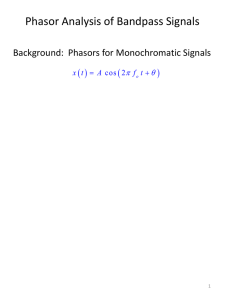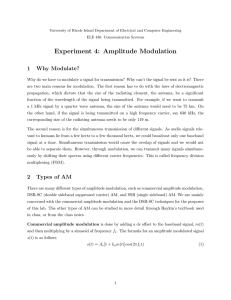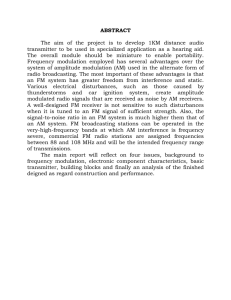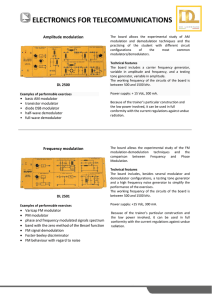DSB-SC and SSB Modulator Lab Experiment
advertisement
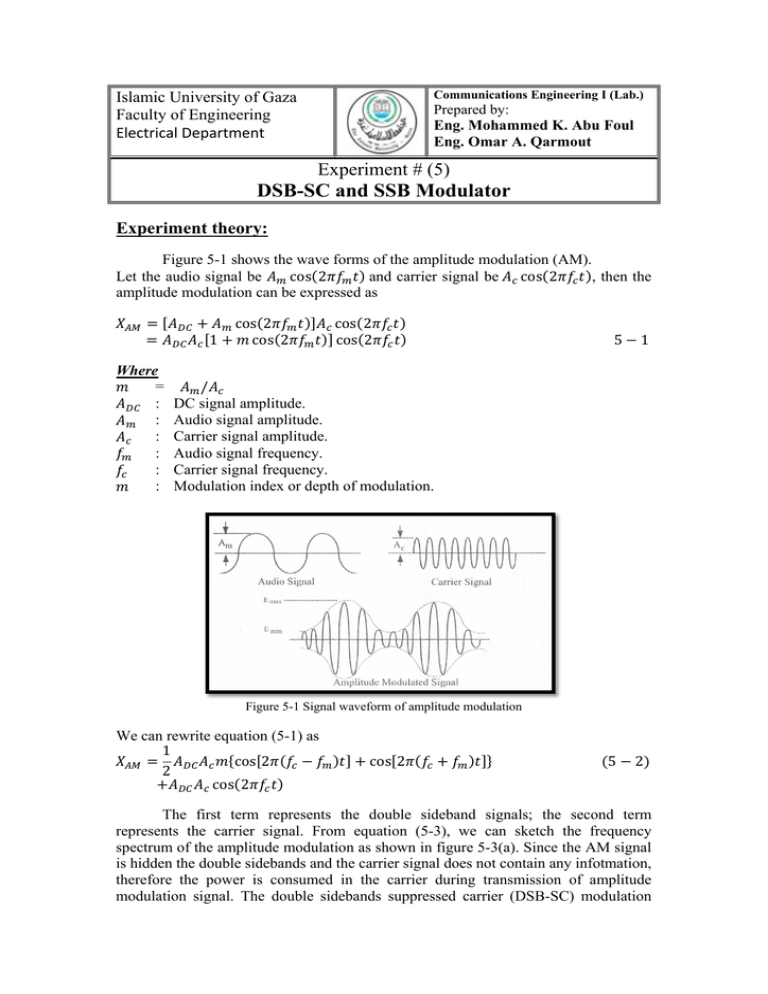
Communications Engineering I (Lab.) Islamic University of Gaza Faculty of Engineering Electrical Department Prepared by: Eng. Mohammed K. Abu Foul Eng. Omar A. Qarmout Experiment # (5) DSB-SC and SSB Modulator Experiment theory: Figure 5-1 shows the wave forms of the amplitude modulation (AM). cos 2 and carrier signal be cos 2 , then the Let the audio signal be amplitude modulation can be expressed as 1 Where = : : : : : : cos 2 cos 2 cos 2 cos 2 5 1 / DC signal amplitude. Audio signal amplitude. Carrier signal amplitude. Audio signal frequency. Carrier signal frequency. Modulation index or depth of modulation. Figure 5-1 Signal waveform of amplitude modulation We can rewrite equation (5-1) as 1 cos 2 2 cos 2 cos 2 5 2 The first term represents the double sideband signals; the second term represents the carrier signal. From equation (5-3), we can sketch the frequency spectrum of the amplitude modulation as shown in figure 5-3(a). Since the AM signal is hidden the double sidebands and the carrier signal does not contain any infotmation, therefore the power is consumed in the carrier during transmission of amplitude modulation signal. The double sidebands suppressed carrier (DSB-SC) modulation means the term cos 2 equals to zero, therefore, it can suppress the carrier signal and only left the double sidebands. DSB-SC modulation can be used to obtain the SSB modulation. Two DSB-SC modulators are utilized and the phase difference between the two audio signals and the carrier signal is adjusted to be 90 degree, i.e. (DSB-SC)Q and (DSB-SC)I , as shown in equations (5-3) and (5-4) DSB SC I DSB SC Q 1 2 cos 2 cos 2 5 3 1 2 cos 2 cos 2 5 4 Equation (5-5) and (5-6) shows that both (DSB-SC)I and (DSB-SC)Q signals are connected to the adder, then USSB or LSSB signal can be obtained at the output port. XLSSB DSB SC I DSB SC Q cos 2 5 5 XUSSB DSB SC I DSB SC Q cos 2 5 6 Figure 5-3(a) is the frequency spectrum of AM signal. We can see that the frequency spectrum consists of three kinds of signals, which is , and . The output voltage of is higher than the other two signals, therefore, the carrier does not contain any information, and the power is consumed in the carrier during transmission of amplitude modulation signal. Figure 5-3(b) is the frequency spectrum of DSB-SC signal. We can see that the frequency spectrum consists of two kinds of signals, which are and . These two kinds of signals consists of the transmission signal, therefore, by using this type of modulation, the power will not consume in the carrier. Besides, as a result of the audio signal is hidden in the double sidebands, so, the stronger the double sidebands signal, the better efficiency of transmission. From equation (5-3), we notice that the larger the modulation index, the better the transmission efficiency. Generally, the modulation index is smaller or equal to 1. If the modulation index is greater than 1, we call this situation as over modulation. For DSB-SC modulation, the modulation index is adjusted to be as large as we can get in order to suppress the carrier from the signal. Figure 5-3(c) and 5-3(d) are the frequency are the frequency spectrum of SSB signal. We can see that the frequency spectrum consists of either signal or signal. Therefore, during transmission, the power consumption of SSB modulation is less than DSB-SC modulation. From above-mentioned discussion, we know that the sequence of power consumption of the three different types of modulation is: Figure 5-2 Block diagram of DSB-SC modulation (a) Frequency spectrum of AM (b) Frequency spectrum of DSB-SC. (c) Frequency spectrum of LSSB (d) Frequency spectrum of HSSB Figure 5-3 Different frequency spectrums of AM modulation. 1- Implementation of DSB-SC Modulator DSB-SC modulation is a kind of AM modulation; therefore, we can utilize the structure of AM modulator to implement the DSB-SC modulator. Figure 5-2 is the block diagram of DSB-SC modulator. We utilize balanced modulator MC1496 to design the DSB-SC modulated signal. Figure 5-4 is the circuit diagram of AM modulator. We can see that the carrier signal and the audio signal belong to signal ended input. The carrier signal is inputted from pin 10 and the audio signal is inputted determine the gain of the whole circuit and determine the from pin 1. Therefore magnitude of bias current. If we adjust the variable resistor VR1 or change the input amplitude of audio signal, then we can control the percentage modulation of amplitude modulation, which means we can adjust the output become the DSB-SC modulation. By adjusting variable resistor VR2, we can control the magnitude of the output amplitude, which is also the gain. Figure 5.4 Circuit diagram of DSB-SC modulation by utilizing MC1496. 2- Implementation of SSB Modulation From equations (5-5) and (5-6), we know that the SSB modulator is the combination of two DSB-SC modulators. Figure 5-5(a) is the block diagram of SSB modulator, where the phase difference of each audio signal and carrier signal of the two DSB-SC modulators is 90o (i.e. 90o phase difference between TP1 and TP2, and 90o phase difference between TP3 and TP4). In figure 5-5(a), the blocks of the quadrature phase shift the phase shift represent the phase shifters. The circuit diagram of phase shifter is in figure 5-5(b). By adjusting the variable resistor, we can control the phase difference between the input and the output phase. The circuits of balance modulator 1 and balance modulator 2 are similar to circuit in figure 5-4. Then the output terminals of the two balanced modulators, which are TP5 and TP6, will be added by the linear adder, and then we can obtain the modulated SSB signal. The circuit diagram of the linear adder is shown in figure 5-5(c). We utilize oscilloscope or spectrum are to observe TP5 and adjust VR1 of the balanced modulator 1, so that the output is modulated DSB-SC signal. By adjusting the variable resistor VR2, we can control the gain of the DSB-SC modulator so that the output amplitude is maximum value without distortion. Similarity, utilize oscilloscope or spectrum are to observe TP6 and adjust VR1 of the balanced modulator 2, so that the output is modulated DSB-SC signal. By adjusting the variable resistor VR2, we can control the gain of the DSB-SC modulator so that the output amplitude is maximum value without distortion. Finally we use spectrum analyzes to observe the output signal terminal is whether the modulated SSB signal. If the frequency spectrum is not true, we can adjust the variable resistor of the quadrature phase shift (a) Block diagram of SSB modulator (b) Circuit diagram of phase shifter. (c) Circuit diagram of linearity adder Figure 5-5 Circuit diagram of linearity adder Experiment Items Experiment: DSB-SC modulator and SSB Modulator 1. To implement a DSB-SC modulator as shown in figure 5-4 or refer to figure ACS5-1 on ETEK ACS-3000-03 module. 2. At the audio signal input port (Audio I/P), input 300mV amplitude and 1 kHz sine wave frequency. Next at the carrier signal port (Carrier I/P), input 300mV amplitude and 100 kHz sine wave frequency. 3. By using oscilloscope, observe on both the audio signal output ports TP1 and TP2 at the same time. Next adjust variable resister 'QPS' so that the phase difference between TP1 and TP2 is 90o. Then record the measured result in table 5-1. By using oscilloscope, observe on both the carrier signal output ports TP3 and TP4 at the same time. Next adjust variable resistor 'phase Adjust' so that the phase difference between TP3 and TP4 is 90o. Then record the measured results in table 5-1. 4. By using oscilloscope, observe the output signal waveforms of DSB-SCQ modulator modulation output port TP5. Next adjust variable resistor VR1 (gain adjustment) so that the output amplitude is maximum without distortion, and also adjust variable resistor VR3 (modulation index adjustment) so that the modulation index is large enough to suppressed the carrier from the signal. Finally, record the measured results in table 5-1. 5. Change the oscilloscope to spectrum analyzer, observe on the output signal waveform of TP5 and record the measure in table 5-1. 6. By using oscilloscope, observe the output signal waveforms of DSB-SCI modulator modulation output port TP6. Next adjust variable resistor VR2 (gain adjustment) so that the output amplitude is maximum without distortion, and also adjust variable resistor VR4 (modulation index adjustment) so that the modulation index is large enough to suppressed the carrier from the signal. Finally, record the measured results in table 5-1. 7. Change the oscilloscope to spectrum analyzer, observe on the output signal waveform of TP6 and record the measure in table 5-1. 8. By using oscilloscope, observe on the output signal waveforms of SSB modulation output port (SSB O/P), then record the measured results in table 5-1. 9. By using spectrum analyzer, observe on the output signal waveforms of SSB modulation output port (SSB O/P), then record the measured results in table 5-1. 10. According to the input signals table 5-2 repeat steps 3-9 and record the results. 11. According to the input signals table 5-3 repeat steps 3-9 and record the results. Table 5-1 (Audio I/P VP=300mV, f =1 kHz; Carrier I/P VP=300mV, f =100 kHz) Measured results of phase adjustment. TP1 and TP2 TP3 and TP4 Measure results of modulated DSB-SC signal (TP5) Oscilloscope Spectrum analyzer Measure results of modulated DSB-SC signal (TP6) Oscilloscope Spectrum analyzer Measure results of modulated SSB signal (SSB O/P) Oscilloscope Spectrum analyzer Table 5-2 (Audio I/P VP=300mV, f =1 kHz; Carrier I/P VP=300mV, f =300 kHz) Measured results of phase adjustment. TP1 and TP2 TP3 and TP4 Measure results of modulated DSB-SC signal (TP5) Oscilloscope Spectrum analyzer Measure results of modulated DSB-SC signal (TP6) Oscilloscope Spectrum analyzer Measure results of modulated SSB signal (SSB O/P) Oscilloscope Spectrum analyzer Table 5-3 (Audio I/P VP=500mV, f =1 kHz; Carrier I/P VP=500mV, f =500 kHz) Measured results of phase adjustment. TP1 and TP2 TP3 and TP4 Measure results of modulated DSB-SC signal (TP5) Oscilloscope Spectrum analyzer Measure results of modulated DSB-SC signal (TP6) Oscilloscope Spectrum analyzer Measure results of modulated SSB signal (SSB O/P) Oscilloscope Spectrum analyzer
